Related Research Articles
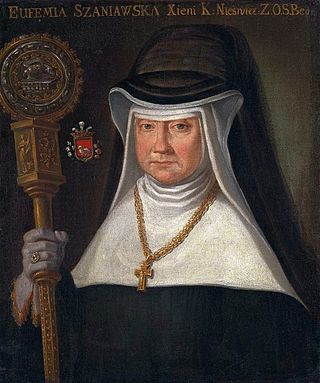
An abbess is the female superior of a community of nuns in an abbey.
The Benedictines, officially the Order of Saint Benedict, are a mainly contemplative monastic religious order of the Catholic Church for men and for women who follow the Rule of Saint Benedict. The male religious are also sometimes called the Black Monks, in reference to the colour of their religious habits, in contrast to other Benedictine orders such as the Olivetans, who wear white. They were founded in 529 by Benedict of Nursia, a 6th-century Italian monk who laid the foundations of Benedictine monasticism through the formulation of his Rule. Benedict's sister, Scholastica, possibly his twin, also became a religious from an early age, but chose to live as a hermit. They retained a close relationship until her death.

Bernard of Clairvaux, O. Cist., venerated as Saint Bernard, was an abbot, mystic, co-founder of the Knights Templar, and a major leader in the reformation of the Benedictine Order through the nascent Cistercian Order.
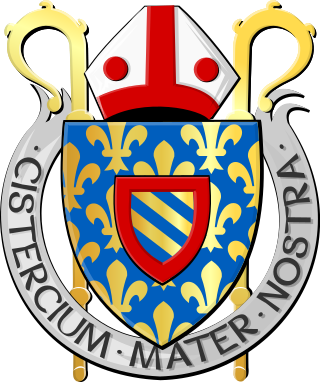
The Cistercians, officially the Order of Cistercians, are a Catholic religious order of monks and nuns that branched off from the Benedictines and follow the Rule of Saint Benedict, as well as the contributions of the highly-influential Bernard of Clairvaux, known as the Latin Rule. They are also known as Bernardines, after Saint Bernard himself, or as White Monks, in reference to the colour of the "cuculla" or cowl worn by the Cistercians over their habits, as opposed to the black cowl worn by Benedictines.
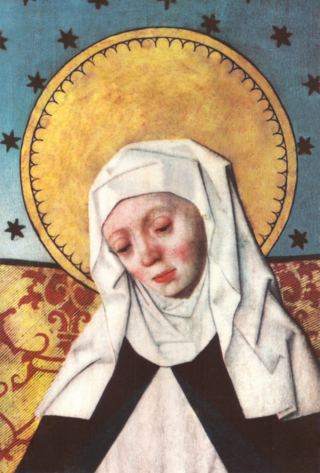
Bridget of Sweden, OSsS born as Birgitta Birgersdotter, also Birgitta of Vadstena, was a Swedish widow, mystic, saint, and the founder of the Bridgettines. Outside Sweden, she was also known as the Princess of Nericia and was the mother of Catherine of Vadstena.
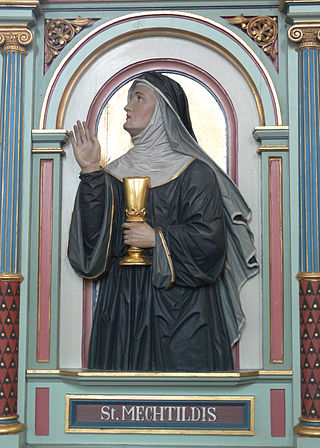
Mechthildof Magdeburg, a Beguine, was a Christian medieval mystic, whose book Das fließende Licht der Gottheit is a compendium of visions, prayers, dialogues and mystical accounts. She was the first mystic to write in Low German.

Memorare is a Catholic prayer seeking the intercession of the Blessed Virgin Mary. It first appears as part of a longer 15th-century prayer, "Ad sanctitatis tuae pedes, dulcissima Virgo Maria." Memorare, from the Latin "Remember," is frequently misattributed to the 12th-century Cistercian monk Saint Bernard of Clairvaux, apparently due to confusion with its 17th-century popularizer, Father Claude Bernard, who stated that he learned it from his own father.
Marie I or Mary was the suo jure Countess of Boulogne from 1159 to 1170. She also held the post of Abbess of Romsey for five years until her abduction by Matthew of Alsace, who forced her to marry him. She is one of several possible identities of the author Marie de France.
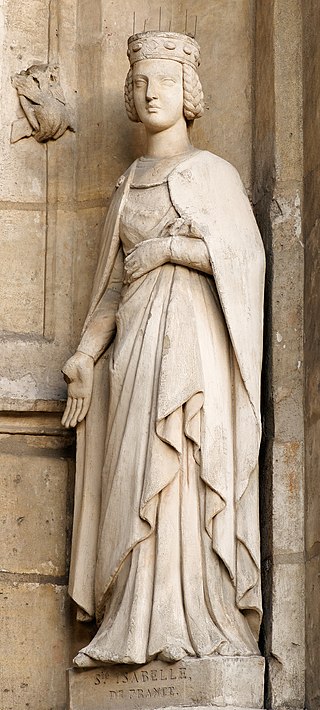
Isabelle of France was a French princess and daughter of Louis VIII of France and Blanche of Castile. She was a younger sister of King Louis IX of France and of Alfonso, Count of Poitiers, and an older sister of King Charles I of Sicily. In 1256, she founded the nunnery of Longchamp in part of the Forest of Rouvray, west of Paris. Isabelle consecrated her virginity and her entire life to God alone. She is honored as a saint by the Franciscan Order. Her feast day is 22 February.
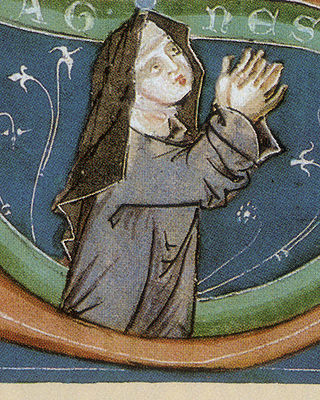
Agnes of Bohemia, O.S.C., also known as Agnes of Prague, was a medieval Bohemian princess who opted for a life of charity, mortification of the flesh and piety over a life of luxury and comfort. Although she was venerated soon after her death, Agnes was not beatified or canonized for over 700 years.
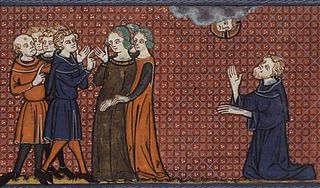
Pelagia, distinguished as Pelagia of Antioch, Pelagia the Penitent, and Pelagia the Harlot, was a Christian saint and hermit in the 4th or 5th century. Her feast day was celebrated on 8 October, originally in common with Saints Pelagia the Virgin and Pelagia of Tarsus. Pelagia died as a result of extreme asceticism, which had emaciated her to the point she could no longer be recognized. According to Orthodox tradition, she was buried in her cell. Upon the discovery that the renowned monk had been a woman, the holy fathers tried to keep it a secret, but the gossip spread and her relics drew pilgrims from as far off as Jericho and the Jordan valley.
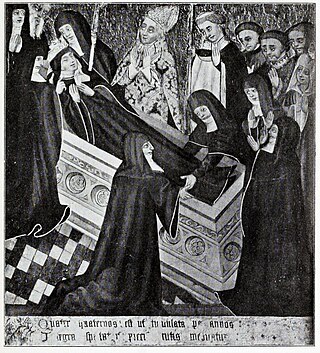
Seaxburh, also Saint Sexburga of Ely, was an Anglo-Saxon queen and abbess, venerated a saint of the Christian Church. She was married to King Eorcenberht of Kent.

Beatrice of Nazareth, also known as Beatrice of Tienen, was a Flemish Cistercian nun, visionary and mystic. Remembered chiefly through a medieval adaptation of her writings, of which the originals are now mostly lost, she is venerated as Blessed by the Catholic Church.
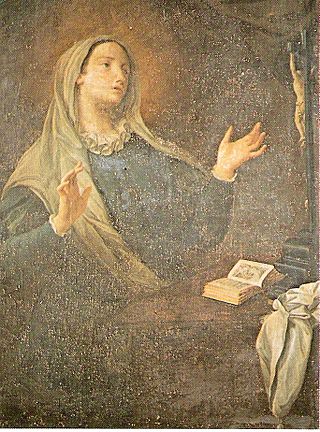
Catherine of Genoa was an Italian Catholic saint and mystic, admired for her work among the sick and the poor and remembered because of various writings describing both these actions and her mystical experiences. She was a member of the noble Fieschi family, and spent most of her life and her means serving the sick, especially during the plague which ravaged Genoa in 1497 and 1501. She died in that city in 1510.

Cistercian nuns are female members of the Cistercian Order, a religious order belonging to the Roman Catholic branch of the Catholic Church.
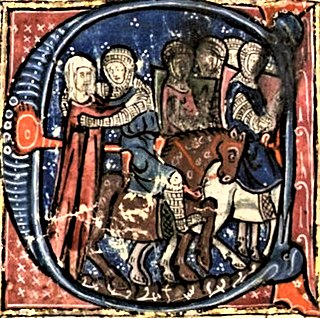
Ida of Lorraine was a saint and noblewoman.

Yvette of Huy was a venerated Christian prophet and anchoress. Born in Huy, Belgium, she was also known as Ivette, Ivetta, Jufta or Jutta.

Maubuisson Abbey is a Cistercian nunnery at Saint-Ouen-l'Aumône, in the Val-d'Oise department of France. It was founded in A.D. 1236 by Blanche of Castile, Queen of France, who may have been buried there in 1252. The site is now within the north-western suburbs of Paris. The surviving buildings are listed as a monument historique.

The Abbey of the Woods was a Bernardine convent in Paris, with buildings at 16 rue de Sèvres and at 11 rue de la Chaise in the 7th arrondissement. The buildings used by the convent were repurposed several times before their destruction in 1907.

Guy IV (c. 1197 – 1226) of the House of Châtillon was the de facto count of Saint-Pol as Guy II from 1219/1223 until his death.
References
- ↑ Alphonse Le Roy, "Ida ou Ide (la bienheureuse)", Biographie Nationale de Belgique , vol. 10 (Brussels, 1889), 6-7.
- ↑ Alphonse Wauters, Histoire des environs de Bruxelles, vol. 3, p. 662.
- 1 2 David Herlihy (1995). Women, Family and Society in Medieval Europe. Berghahn. pp. 170–171. ISBN 978-1-57181-024-3.
- 1 2 Michael J. Walsh (2007). A New Dictionary of Saints: East and West. Liturgical Press. p. 275. ISBN 978-0-8146-3186-7.
- ↑ Cistercians (1872). The Cistercian fathers, or, Lives and legends of certain saints and blessed of the Order of Citeaux. Translated by H. Collins. pp. 163–170.
- ↑ Constance Classen (2012). The Deepest Sense: A Cultural History of Touch. University of Illinois Press. pp. 86–87. ISBN 978-0-252-09440-8.
- ↑ Basil Watkins (ed.), The Book of Saints (7th ed., London, 2002), p. 273.